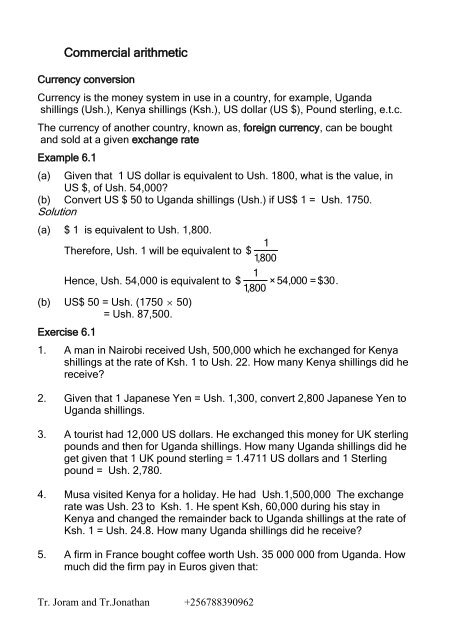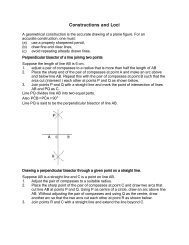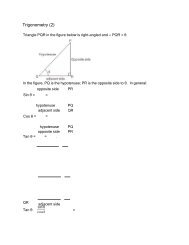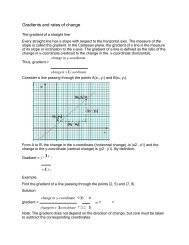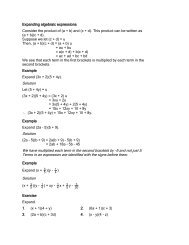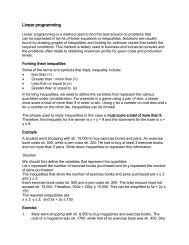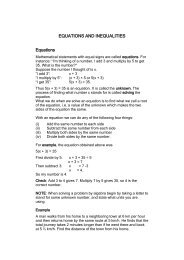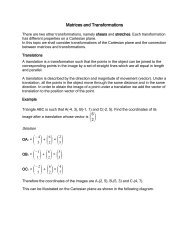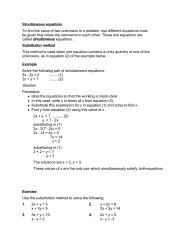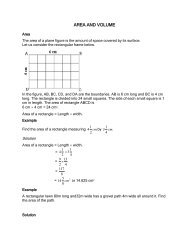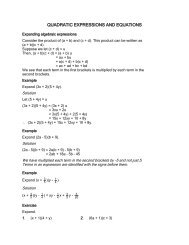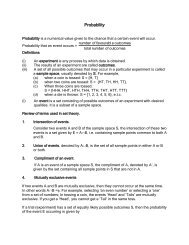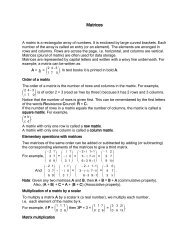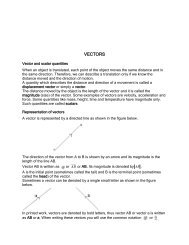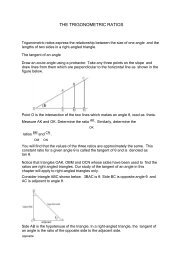J14
You also want an ePaper? Increase the reach of your titles
YUMPU automatically turns print PDFs into web optimized ePapers that Google loves.
Commercial arithmetic<br />
Currency conversion<br />
Currency is the money system in use in a country, for example, Uganda<br />
shillings (Ush.), Kenya shillings (Ksh.), US dollar (US $), Pound sterling, e.t.c.<br />
The currency of another country, known as, foreign currency, can be bought<br />
and sold at a given exchange rate<br />
Example 6.1<br />
(a) Given that 1 US dollar is equivalent to Ush. 1800, what is the value, in<br />
US $, of Ush. 54,000?<br />
(b) Convert US $ 50 to Uganda shillings (Ush.) if US$ 1 = Ush. 1750.<br />
Solution<br />
(a) $ 1 is equivalent to Ush. 1,800.<br />
1<br />
Therefore, Ush. 1 will be equivalent to $<br />
1,800<br />
1<br />
Hence, Ush. 54,000 is equivalent to $ ×54,000 = $30.<br />
1,800<br />
(b) US$ 50 = Ush. (1750 50)<br />
= Ush. 87,500.<br />
Exercise 6.1<br />
1. A man in Nairobi received Ush, 500,000 which he exchanged for Kenya<br />
shillings at the rate of Ksh. 1 to Ush. 22. How many Kenya shillings did he<br />
receive?<br />
2. Given that 1 Japanese Yen = Ush. 1,300, convert 2,800 Japanese Yen to<br />
Uganda shillings.<br />
3. A tourist had 12,000 US dollars. He exchanged this money for UK sterling<br />
pounds and then for Uganda shillings. How many Uganda shillings did he<br />
get given that 1 UK pound sterling = 1.4711 US dollars and 1 Sterling<br />
pound = Ush. 2,780.<br />
4. Musa visited Kenya for a holiday. He had Ush.1,500,000 The exchange<br />
rate was Ush. 23 to Ksh. 1. He spent Ksh, 60,000 during his stay in<br />
Kenya and changed the remainder back to Uganda shillings at the rate of<br />
Ksh. 1 = Ush. 24.8. How many Uganda shillings did he receive?<br />
5. A firm in France bought coffee worth Ush. 35 000 000 from Uganda. How<br />
much did the firm pay in Euros given that:<br />
Tr. Joram and Tr.Jonathan +256788390962
1 Euro = 0.9461 US dollars and 1 US dollar = Ush. 1 950.<br />
6. A Ugandan bought a car from Japan for Ush. 6 000 000. How much did<br />
he pay for the car in Japanese Yen if 1 Japanese Yen = 1.13 US dollars<br />
and 1 US dollar = Ush. 1 720.<br />
7. A Forex Bureau buys one US dollar at Ush.1,900 and sells one Pound<br />
Sterling at Ush.3,450. Atim wants to exchange 3,000 US dollars to pound<br />
sterling. How many pounds sterling will she get?<br />
Profit and Loss<br />
Cost price is the price at which goods are bought. It is also called the buying<br />
price or purchase price. Selling price is the price at which goods are sold by the<br />
second seller (retailer).<br />
If the selling price is more than the cost price, we say that a profit has been<br />
made. Thus, profit = selling price – cost price.<br />
Sometimes the cost price is more than the selling price. We call the difference<br />
between the two a loss. Thus, loss = cost price – selling price.<br />
Percentage profit and loss<br />
It is common to express the profit or loss as a percentage. Usually the<br />
percentage profit or loss is calculated as a percentage of the cost price. Thus,<br />
profit<br />
percentage profit = ×100 % and,<br />
cos t price<br />
loss<br />
percentage loss = ×100 %.<br />
cos t price<br />
Example 6.2<br />
A trader buys goods for sh. 300 000 and sells them for sh. 360 000. Calculate<br />
the percentage profit.<br />
Solution<br />
Cost price = sh. 300 000<br />
Selling price = sh. 360 000<br />
Profit = sh. 360 000 – sh. 300 000<br />
= sh. 60 000<br />
60000<br />
Percentage profit = ×100%<br />
300000<br />
= 20%.<br />
Example 6.3<br />
©Kyebambe Girls’ SS 2015 3
A shopkeeper sells a dress for sh. 23 000 thereby making a profit of 15%.<br />
Calculate the cost price of the dress.<br />
Solution<br />
Selling price = sh. 23 000<br />
This is 115% of the cost price which is 100%<br />
100<br />
Therefore, cost price = × 23000 = sh. 20 000.<br />
115<br />
Alternatively, let the cost price be sh. X<br />
Selling price = sh. 23 000<br />
Percentage profit = 15%<br />
23000 x<br />
= 100<br />
%<br />
x<br />
23000 x<br />
Therefore, 100<br />
= 15<br />
x<br />
2 300 000 – 100x = 15x<br />
2 300 000 = 115x<br />
2300000<br />
x = = 20 000<br />
115<br />
Therefore, cost price = sh. 20 000.<br />
Exercise 6.2<br />
1. A man bought a bicycle at sh. 58 000. He sold it at a profit of 10%. What<br />
was his selling price?<br />
2. A dealer buys an item for sh. 8 000. He wishes to make a profit of 35%.<br />
What should the selling price be?<br />
3. A radio that cost sh. 15 000 was sold at a loss of 18%. What was the<br />
selling price?<br />
4. A shopkeeper sells a bag for sh. 32 000, making a loss of 20%. What is<br />
the cost price?<br />
5. By selling a table for sh. 31 500, a shopkeeper makes a profit of 15%.<br />
Calculate the actual profit.<br />
6. An agent buys 200 items at a total cost of sh. 600 000. She sells 150 of<br />
them at a profit of 25% and the remainder at a loss of 8%. Find the<br />
amount of her net profit and express it as a percentage of the initial cost<br />
of all the items.<br />
©Kyebambe Girls’ SS 2015 4
7. A retailer buys 30 boxes of strawberries at sh. 3000 each and sells 27<br />
boxes at 30% profit. How much profit does he make?<br />
8. At a sale, the marked prices were reduced by 10%.<br />
(a) How much would a buyer have to pay for a shirt marked sh. 25 000?<br />
(b) If a customer pays sh. 48 000 for a dress. What is the marked price?<br />
Discount<br />
Sometimes a business reduces a small fraction of the selling price if the<br />
customer either pays cash or buys a lot of goods. This reduction is called<br />
discount. Most of the time, discounts are expressed as a percentage of the<br />
original price.<br />
Example 6.4<br />
A television set is selling at sh. 150 000. A customer is offered 4% discount for<br />
paying cash. How much does the customer pay for the TV?<br />
Solution<br />
Discount = 4% of sh. 150 000<br />
= sh. 6 000.<br />
The customer pays sh. 150 000 – sh. 6 000 = sh. 144 000<br />
Commission<br />
Sometimes firms use agents who are not actually their employees to sell their<br />
goods. The agent is usually paid a commission for selling the goods.<br />
Commission is normally given as a percentage of the sales made.<br />
Example 6.5<br />
A saleslady sold goods worth sh. 750 000. She was paid 2% commission on<br />
the sales. How much commission did she get?<br />
Value of goods sold = sh. 750 000<br />
2<br />
Commission paid is = ×750 000<br />
100<br />
= sh. 15 000<br />
Interest<br />
Simple interest<br />
If you borrow money from a bank or other financial institution then you will have<br />
to pay interest (the charge paid for borrowing) in addition to your repayments.<br />
©Kyebambe Girls’ SS 2015 5
The money borrowed or lent is called the principal. When interest is paid at<br />
fixed intervals, yearly, half-yearly, quarterly or monthly, the principal is said to<br />
be lent (or borrowed) at simple interest.<br />
The interest is calculated on the original principal only. The investor receives<br />
interest at regular periods, the principal remains the same. Simple interest is<br />
calculated using the following formula<br />
P×R× T<br />
Interest =<br />
100<br />
Where, P = principal, R = rate of interest per annum (%); T = time (in years).<br />
Note that the units for R and T must be consistent, i.e.<br />
If R is per annum, T must be in years,<br />
If R is per month, T must be in months, e.t.c.<br />
When the simple interest for any given time is added to the principal, the sum is<br />
called the amount at simple interest for that time.<br />
Amount = Principal + Interest, i.e. A = P + I.<br />
Example 6.6<br />
Find the simple interest on sh. 25 000 for 3.5 years at 18% per annum.<br />
Solution<br />
I =<br />
P×R× T<br />
100<br />
Example 6.7<br />
25000 ×18 ×3.5<br />
=<br />
100<br />
= sh. 15 750.<br />
3 1<br />
Find the simple interest on sh. 20 000 for 1 years at 1 % per month. Find<br />
4 2<br />
3<br />
also, the amount after 1 years.<br />
4<br />
Solution<br />
3<br />
1<br />
Time = 1 years × 12 = 21 months; P = sh. 20 000; R = 1 % per month<br />
4<br />
2<br />
1<br />
20000 ×1<br />
2<br />
× 21<br />
Therefore,<br />
= sh. 6 300.<br />
100<br />
Amount = Principal + Interest<br />
= 20 000 + 6 300 = sh. 26 300.<br />
Compound interest<br />
In most financial institutions, interest is added to the money borrowed or lent<br />
and then the interest is calculated on this total amount for the next period.<br />
©Kyebambe Girls’ SS 2015 6
Adding the interest is known as compounding the interest, or just compound<br />
interest.<br />
Compound interest = Final amount – original principal.<br />
Note: Simple interest is the same for each period, compound interest becomes<br />
greater for successive periods.<br />
Example 6.8<br />
Calculate the compound interest on sh. 2 000 for 2 years at 8% per annum.<br />
Solution<br />
First year: Principal = 2 000<br />
Interest = 160 calculated as I =<br />
Amount = 2000 + 160 = 2 160<br />
Second year:<br />
Principal = 2 160<br />
2000 ×8×1<br />
= 160<br />
100<br />
2160 ×8×1<br />
Interest = 172.80, calculated as I 2<br />
=<br />
= 172.80<br />
100<br />
Amount = 2 160 + 172.80 = 2 332.80<br />
Compound interest = Amount – Principal<br />
= 2 332.80 – 2 000 = sh. 332.80<br />
Alternatively, the compound interest can be calculated using the following<br />
formula:<br />
n<br />
A = P 1+<br />
<br />
R<br />
100<br />
where, A is the amount after n years; P = principal; R is the rate % p.a. and n is<br />
the number of years. If interest is added half yearly, the value of R is half of the<br />
given R% p.a. value and n is doubled.<br />
So, when P = 2 000, R = 8 and n = 2,<br />
Amount = 2000(1.08) 2 = 2 332.80<br />
Interest = Amount – principal<br />
= 2 332.80 – 2000<br />
= sh. 332.80<br />
Appreciation and depreciation<br />
Appreciation is a term used to describe an increase in value of an asset. On the<br />
other hand, depreciation is used to mean a decrease in value of an asset.<br />
The increase or decrease in value is usually expressed as a percentage of the<br />
original value.<br />
Note: The depreciation is calculated as a percentage of the remainder after the<br />
first period’s depreciation has been subtracted.<br />
©Kyebambe Girls’ SS 2015 7
For example, if a car depreciates at the rate of 10% per year, car costing<br />
10<br />
Sh. 5 000 000 will depreciate by × 5000000 after 1 year.<br />
100<br />
Therefore, its value after 1 year = 5 000 000 – 500 000 = sh. 4 500 000.<br />
10<br />
After 2 years its depreciation will be × 4500000 = 450 000<br />
100<br />
Therefore, its value after 2 years will be 4 5000 000 – 450 000 = sh. 4 050 000.<br />
(The value of the car after 2 years is not 5 000 000 – 50 000 – 50 000 = 4 900 000)<br />
Exercise 6.3<br />
1. As a result of a civil war, the population of a town decreased by 4% of its<br />
total population of 425 000 at the beginning of the year. Then after, it<br />
increased by 2% of its size at the beginning of the year for consecutive<br />
five years. Calculate, to the nearest thousand, its population at the end of<br />
this period.<br />
Calculate also, correct to one decimal place, the percentage increase<br />
over this period.<br />
2. Find the amount to which sh. 10 000 accumulates in 12 years at 9% per<br />
annum compound interest.<br />
3. A savings and credit society granted a short-term loan of sh. 65 000 at<br />
20% per month simple interest. Calculate the interest after 3 months.<br />
4. The amount of an investment at 4% p.a. compound interest after 6<br />
months is sh. 54 200. Calculate the principal.<br />
5. A man loans a friend sh. 500 000 for 2 years at 7% compound interest .<br />
How much will he receive when the loan is repaid?<br />
6. A car rental company hires out cars as follows: sh. 23 000 per day and sh.<br />
1 000 per kilometer covered. They offer a discount of 40 km free each day<br />
of hire. A man hires a car for 5 days and drives for 350 km. Calculate the<br />
total cost.<br />
7. The price of a car when new is sh. 14 000 000. After one year its market<br />
value depreciates by 15%. In each subsequent year it depreciates by 10%<br />
of its value by the beginning of the year. Find its value to the nearest<br />
shillings, at the end of three years.<br />
8. A business man had sh. 1 200 000 and divided it in the ratio 3:2. He used<br />
the larger amount to buy a car, and invested the remainder in a bank<br />
which paid simple interest at a rate of 8% per annum. After 18 months, he<br />
©Kyebambe Girls’ SS 2015 8
sold the car at 30% less than what he bought it at. He also withdrew his<br />
money and interest from the bank. Calculate:<br />
(a) the amount he invested in the bank.<br />
(b) the amount for which he sold the car.<br />
(c) the total amount he withdrew from the bank.<br />
(d) the percentage of the sh. 1 200 000 he had after selling the car.<br />
9. A car valued at sh. 8 900 000 is supposed to depreciate each year at 10%<br />
of its value at the beginning of the year. Find its value after three years.<br />
10. A plot of land bought for sh. 5 000 000 appreciated by 12% in the first<br />
year and subsequently for 2 more years at 10%. Find its value after 3<br />
years.<br />
11. A man is offered a choice for his salary:<br />
(a) Starting salary: Ush. 15 000 000 per year with an annual increase of<br />
10% of the salary at the beginning of the year for three years.<br />
(b) Starting salary: Ush. 16 500 000 per year with an annual increase of<br />
5% of the salary at the beginning of the year for 3 years.<br />
(i) what will be his total earnings in the first 3 years in each<br />
case?<br />
(ii) What will be his salary at the beginning of the fourth year in<br />
each case?<br />
12. The value of the machinery in a factory depreciates each year by 25% of<br />
the value at the beginning of the year. If it was valued at sh. 750 000 after<br />
3 years, find its value when new.<br />
13. For a fixed deposit for 4 years, a bank offers the rates of interest: 10% in<br />
the first year, 12% in the second year and 15% in each subsequent year.<br />
Find the sum to which a fixed deposit of sh. 800 000 will amount after 4<br />
years.<br />
14. The price of a car was increased by 10% to sh.8,800,000.<br />
(i)<br />
(ii)<br />
What was the original price of the car?<br />
If Tom bought this car at this increased price and sold it a year later<br />
at 20% discount. Express Tom’s selling price as a percentage of the<br />
original price.<br />
15. Find the rate of compound interest levied on sh.8,000 when it has been<br />
deposited for 3 years and earned sh.27,000.<br />
Hire Purchase<br />
This is a system of payment where a customer is allowed to buy an item by<br />
paying part of the price in cash and then making a fixed payment each month<br />
for a number of months.<br />
©Kyebambe Girls’ SS 2015 9
The first payment is called deposit or down payment, the monthly fixed payment<br />
is called monthly installment.<br />
The hire purchase price is usually more than the marked price.<br />
Example 6.9<br />
The marked price of a gas cooker is sh. 450 000. A dealer charges 20% more<br />
under hire purchase. If the deposit is sh. 30 000, calculate the amount of<br />
monthly installments if there are 12 equal installments.<br />
Solution<br />
Marked price = sh. 450 000.<br />
Hire purchase price = sh. 120% of sh. 450 000<br />
120<br />
= × 450000<br />
100<br />
= sh. 540 000<br />
Deposit = sh. 30 000<br />
540000 30000<br />
Monthly installments =<br />
12<br />
= sh. 42 500<br />
Example 6.10<br />
A colour TV set is available under hire purchase on payment of a deposit of sh.<br />
20 000 and ten equal monthly installments of sh. 20 000 each. If the cash price<br />
is sh. 200 000, calculate what percentage goes the dealer charge extra over the<br />
cash price?<br />
Solution<br />
Deposit = 20 000<br />
Installments = 10 × 20 000 = 200 000<br />
Hire purchase price = Deposit + Installments<br />
= 20 000 + 200 000 = 220 000<br />
Cash price = 200 000<br />
Extra payment = 220 000 – 200 000 = sh. 20 000.<br />
20000<br />
Therefore, percentage = ×100%<br />
= 10% of cash price.<br />
200000<br />
Exercise 6.4<br />
1. A sewing machine is sold under hire purchase: a deposit of sh. 25 000<br />
and 12 monthly installments of sh. 16 500 each. If the hire purchase is<br />
18% higher than the cash price, determine the cash price.<br />
©Kyebambe Girls’ SS 2015 10
2. A dealer marks a price sh. 4 800 of an article. He charges 10% extra<br />
under hire purchase with a deposit of sh.800 and four equal monthly<br />
installments. Calculate the amount of monthly installments.<br />
3. The cash price of a refrigerator is sh. 290 000 and its hire purchase price<br />
is 15% higher under 12 monthly installments of sh. 25 000 each.<br />
Determine the amount of deposit.<br />
4. A dealer displays the following label on an article:<br />
Cash or down payment: sh. 250 000.<br />
12 equal monthly installments of sh. 500 000.<br />
If he is charging 25% higher than the cash price, determine the cash<br />
price of the article<br />
5. The cash price of a bicycle is sh. 70 000. If the same is bought under HP<br />
terms, then there is a deposit of 10% and 12 monthly installments of<br />
sh. 7 000. Find the difference between the two prices.<br />
6. A scientific calculator is marked at sh. 45 000. Under hire purchase it is<br />
available for a down payment of sh. 20 000 and six monthly installments<br />
of sh. 6 000 each. Calculate the<br />
(a) hire purchase price<br />
(b) extra amount paid over the cash price.<br />
7. The marked price of a article is sh. 25 000. James bought it by paying a<br />
deposit of sh. 5 000 and a number of equal monthly installments of<br />
sh. 2 500. If the hire purchase price is 20% higher than the marked price,<br />
calculate the number of installments.<br />
8. A cash discount of 10% is allowed on a refrigerator whose marked price<br />
is sh. 200 000. Hire Purchase terms are: a deposit of 20%, and 12<br />
monthly installments of sh. 19 500 each. Find the difference between the<br />
cash price and the payment required under HP terms<br />
Income Tax<br />
This is a tax levied on peoples’ incomes. Income is a payment received by<br />
Someone who gets involved in a legal gainful activity. Examples include: Profit,<br />
©Kyebambe Girls’ SS 2015 11
salary, wages, interest, commission, fees, rent, overtime pay e.t.c.<br />
Gross income is the total income that an individual receives from wages,<br />
salary, leave pay, overtime pay, medical allowance, transport allowance e.t.c.<br />
Taxable income is the income on which income tax is levied. It is arrived at by<br />
deducting from the gross income the amount of allowances.<br />
Thus, taxable income = gross income – allowances<br />
Example 6.11<br />
In a certain country income tax is levied as follows: A person’s monthly gross<br />
Income has certain allowances deducted from it before it is subjected to<br />
taxation.<br />
Each child below ten years sh. 5 000<br />
Each child above ten years but less than 18 years – sh. 7 000<br />
Married man: sh. 18 000<br />
Transport allowance: sh. 17 000<br />
David earns sh. 450 000 per month, he is married with 3 children of ages between 2 and<br />
10 years, 2 children above twelve but less than 18 years.<br />
Calculate:<br />
(i) the taxable income of David<br />
(ii) the income tax he paid; if the rates are:<br />
Taxable income (sh)<br />
Rate(%)<br />
0 – 100 000 10<br />
100 001 – 200 000 20<br />
200 001 – 300 000 30<br />
300 001 – 400 000 45<br />
400 001 - and above 50<br />
Solution<br />
(i)<br />
David’s allowances<br />
Marriage 18 000<br />
Transport 17 000<br />
3 children 3 х 5 000 = 15 000<br />
2 children 2 х 7 000 = 14 000<br />
Total allowances 64 000<br />
Taxable income = 450 000 – 64 000<br />
= sh. 386 000<br />
©Kyebambe Girls’ SS 2015 12
(ii) income tax (sh.)<br />
10<br />
100 000 100 000 х<br />
100<br />
= 10 000<br />
20<br />
100 000 100 000 х<br />
100<br />
30<br />
100 000 100 000 х<br />
100<br />
45<br />
86 000 86 000 х<br />
100<br />
= 20 000<br />
= 30 000<br />
= 38 700<br />
Total income tax = sh. 98 700<br />
Example 6.12<br />
The table below shows the income tax rate of a certain country for government<br />
employees. This is applied after the allowances have been already deducted.<br />
Taxable income (sh)<br />
Rate(%)<br />
0 – 100 000 0<br />
100 001 – 200 000 5<br />
200 001 – 300 000 10<br />
300 001 – 450 000 20<br />
450 001 - 550 000 30<br />
550 001 – and above 50<br />
An employee has a gross monthly income of sh. 600 000 and is entitled to the<br />
following allowances.<br />
Marriage: sh. 120 000 per annum<br />
Housing and transport:10% of the gross monthly income.<br />
Medical care: sh. 240 000 per annum.<br />
Calculate:<br />
(i) the amount an employee pays as monthly income tax.<br />
(ii) the net monthly income.<br />
Solution<br />
(i)<br />
Allowances:<br />
Marriage 120 000 12 = 10 000<br />
©Kyebambe Girls’ SS 2015 13
(ii)<br />
10<br />
Housing and transport 600000 =<br />
100<br />
60 000<br />
Medical care sh. 240 000 12 = 20 000<br />
Total allowances = 90 000<br />
Taxable income = monthly gross income – monthly allowances<br />
= 600 000 – 90 000<br />
= sh. 510 000.<br />
Income (sh.):<br />
tax (sh.)<br />
100 000 0<br />
100 000 5 100 000<br />
100<br />
= 5 000<br />
100 000 10 100 000<br />
100<br />
= 10 000<br />
150 000 20 150 000<br />
100<br />
= 30 000<br />
60 000 30 60 000<br />
100<br />
= 18 000<br />
Total monthly income tax = 63 000.<br />
Therefore, the total monthly income tax is sh. 63 000<br />
Net monthly income = gross monthly income – income tax.<br />
= 600 000 – 63 000<br />
= sh. 537 000.<br />
Exercise 6.5<br />
1. In a certain country, income tax is computed after deducting the following<br />
allowances:<br />
TYPE OF ALLOWANCE<br />
AMOUNT (USH.)<br />
Marriage 10 000<br />
Single 4 000<br />
Each child above 10 but below 20 years 3 000<br />
Each child under 10 years 2 000<br />
Omoja is married with 3 children, two below 10 years of age and the other child<br />
12 years old. Mbili is single but has two dependants aged 11 and 15 years. Each<br />
month Omoja and Mbili earn gross incomes of sh. 130 000 and sh. 120 000<br />
respectively. The income tax is calculated as follows:<br />
Ush.<br />
%age tax<br />
©Kyebambe Girls’ SS 2015 14
1 st : 01 - 10 000 20<br />
Next: 10 001 – 50 000 15<br />
Rest: 50 001 – and above 10<br />
(a) Calculate the:<br />
(i) taxable income for Omoja and Mbili,<br />
(ii) income tax for Omoja and Mbili,<br />
(b) Express the total income tax for each man as percentage of their<br />
respective taxable incomes.<br />
2. In a certain country, tax is levied on income per month as follows:<br />
Income per month (sh)<br />
Tax Rate(%)<br />
0 – 50 000 10<br />
50 001 – 100 000 15<br />
100 001 – 150 000 20<br />
150 001 – 200 000 30<br />
200 001 - 250 000 35<br />
250 001 – 300 000 40<br />
300 001 – 350 000 45<br />
350 001 – and above 55<br />
Tom’s gross monthly income is sh. 766 000.<br />
The allowances given to him are:<br />
Housing allowance:<br />
Marriage allowance:<br />
Medical allowances:<br />
Transport allowances:<br />
Insurance premium:<br />
sh. 10 000 pe month<br />
sh. 919 200 per annum.<br />
sh. 50 000 per month<br />
sh. 120 000 per annum<br />
sh. 72 000 per annum<br />
Tom is married with 5 children: 2 above 10 years but below 18 years, 1 is below 10<br />
years while 2 are above 18 years. The rate per child are as below:<br />
Age<br />
rate:<br />
Below 10 years sh. 3 000<br />
Between 10 and 18 years sh. 4 000<br />
Above 18 years sh. 5 000<br />
©Kyebambe Girls’ SS 2015 15
(a)<br />
(b)<br />
Calculate:<br />
(i) Tom’s taxable income,<br />
(ii) the income tax Tom pays.<br />
Express his income tax as a percentage of his monthly income.<br />
3. (a) Adikini bought a TV set for which the cash price was shs. 599,000.<br />
She bought the TV set on hire purchase terms and had to pay an extra<br />
sh. 71 000. If she made eight equal monthly instalments, how<br />
much did<br />
she pay per month?<br />
(b) Mukasa wants to buy a house which is priced at sh. 56,000,000. A<br />
deposit of 25% of the value of the house is required. A bank will lend<br />
him the rest of the money at a compound interest of 15% per annum and<br />
payable after two years.<br />
Calculate the:<br />
(i) deposit Mukasa must make.<br />
(ii) amount of money Mukasa will have to pay the bank after two<br />
years.<br />
(iii) total money which Mukasa will spend to buy the house.<br />
©Kyebambe Girls’ SS 2015 16


